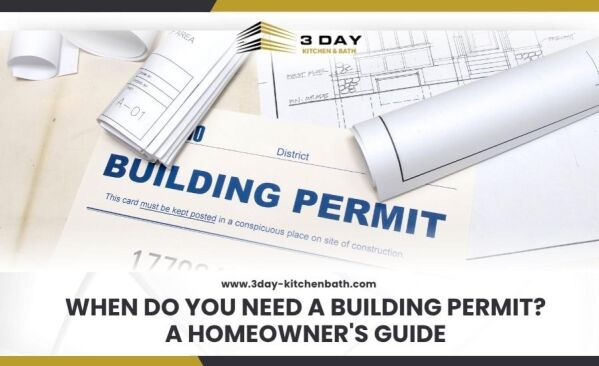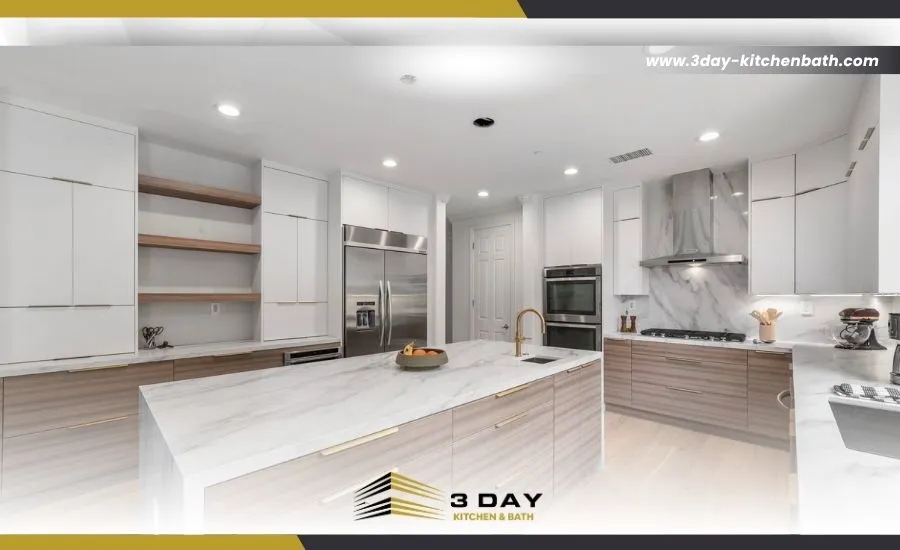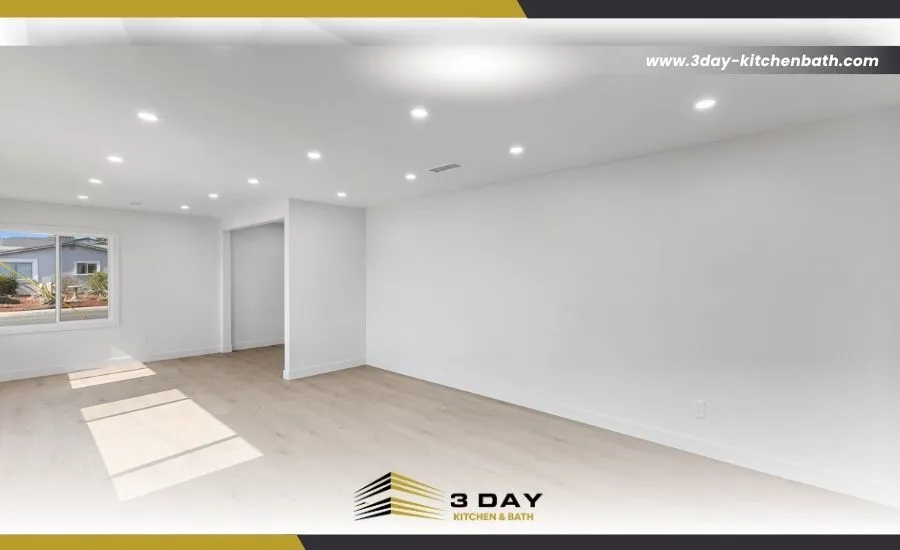Whether you need a building permit depends on the scope of your project. You need one for structural, plumbing, or electrical changes, but not for simple visual updates.
Planning a new kitchen or bath is exciting. That excitement can stop when you ask, "Do I need a permit for this?" The rules can be confusing, but they are in place for a good reason.
Let's clear up the confusion so you can plan your project with confidence, as planning your home remodel is the crucial first step. This guide explains which kitchen and bath projects require permits and what to expect from the process.
- Do You Need a Permit for Your Project?
- What Is a Building Permit (And Why Is It So Important)?
- The Different Types of Permits for a Remodel
- Projects That Almost Always Require a Permit
- Projects That Typically Do Not Require a Permit (Visual Fixes)
- The 4-Step Permit Process
- Start Your Remodel Without the Stress
- Frequently Asked Questions About
- What happens if you remodel without a permit?
- How much does a building permit cost?
- Do I need a permit to replace cabinets?
- Can a homeowner pull their own permits?
- How long does it take to get a building permit?
Do You Need a Permit for Your Project?
Here is a quick checklist for common kitchen and bath projects. Remember to always check your local rules, as they can vary.
- Painting or Wallpapering? No Permit.
- Replacing Flooring (Tile, Vinyl)? No Permit.
- Replacing Countertops? Usually, No Permit.
- Replacing a Faucet in the same location? No Permit.
- Replacing Cabinets in the same location? Usually, no permit.
- Moving a Sink or Dishwasher? Yes, Plumbing Permit.
- Adding New Outlets or Lights? Yes, Electrical Permit.
- Moving an Outlet or Light Switch? Yes, Electrical Permit.
- Moving or Removing a Wall? Yes, Building Permit.
- Changing your kitchen or bath layout? Yes, Multiple Permits. (Need to know if you need a permit to remodel a kitchen?)
This checklist provides a quick answer. Now, let's explore why these rules exist and what a building permit actually is.
What Is a Building Permit (And Why Is It So Important)?
A building permit is an official approval from your local building department to start your remodel. The permit process ensures your project is safe, legal, and built correctly. This process protects you in three main ways.
- Protection (Safety): Permits ensure that your project complies with local building codes. An official inspector visits your home at key stages. This inspection confirms that work such as wiring or plumbing is performed safely to prevent fires or leaks.
- Property Value (Legality): Unpermitted work is a major red flag for buyers and lenders. It can stop a future sale or force you to lower your price. A completed permit indicates that your home's records show the work was done correctly.
- Peace of Mind (Insurance): If a fire starts from unpermitted electrical work, your homeowner's insurance may deny the claim. Permits prove the work was done to code, which protects your coverage.
Following these rules protects you, but it requires getting the right permit. A "building permit" is a general term, and a full remodel often requires a bundle of different types.
The Different Types of Permits for a Remodel
A remodel often requires a "bundle" of permits, not just one. A kitchen or bath project can involve three main types.
- Building Permit: This is required for structural changes, such as moving or removing walls.
- Plumbing Permit: You need this for any work that changes supply or drain lines. This includes moving a sink or toilet.
- Electrical Permit: You need this to add new circuits or relocate existing wiring. This includes new outlets or lighting.
These three permit types directly map to the three main categories of work that will always require an official application and inspection.
Projects That Almost Always Require a Permit
You almost always need a permit when you change your home's "bones." This falls into three categories.
- Structural Changes: This refers to changing any wall, whether it is load-bearing or not. Removing the wall between your kitchen and dining room or adding a new window are projects that require a permit.
- Plumbing Changes: You will need a permit for a bathroom remodel or kitchen update that changes the pipes. This includes moving a sink to an island or moving a toilet. When it comes to a permit to remodel a bathroom, the answer is almost always yes for plumbing changes.
- Electrical Changes: Yes, if you add or move wiring. Running power to a new island, adding recessed lights, or moving an outlet are all electrical projects that need a permit.
Just as important as knowing what requires a permit is knowing what does not. You can save time and effort on the following simple visual updates.
Projects That Typically Do Not Require a Permit (Visual Fixes)
You usually do not need a permit for simple visual fixes. If you are replacing an item in the exact same spot, you are often clear. This includes painting, wallpapering, and installing new flooring.
- Direct Replacements and Visual Updates: No, you usually do not need a permit to replace cabinets. This is true as long as you are not moving the plumbing, electrical, or walls behind them. If you hang new cabinets in the same layout, it is considered a visual update.
If your project goes beyond these visual fixes, you will need to start the permit process. It involves more than just paying a fee; it's a four-step journey.
The 4-Step Permit Process
The permit process includes of four main steps: planning, review, inspection, and approval.
- Planning and Submission: You must submit detailed plans with your application. These plans often require the expertise of a designer or architect.
- The Plan Review: A city official reviews your plans to check for code compliance. This step can take weeks or even months.
- The Inspections: A permit requires multiple inspections at key stages. An inspector must approve "rough-in" work (such as new plumbing or wiring) before it is covered by drywall. This means pausing work to schedule appointments, which can cause delays.
- Final Approval: After all work is done, a final inspection "closes out" the permit. Your project is now officially complete and in compliance with all applicable laws.
That four-step process is a major undertaking for a homeowner. It is time-consuming, complex, and filled with potential delays.
Start Your Remodel Without the Stress
The easiest way to remodel is to hire a professional design-build firm for your home remodeling in San Diego to manage the entire permit process. The permit journey is confusing and stressful.
A firm like 3 Day Kitchen & Bath handles everything for you. We are licensed contractors who are familiar with building codes. Schedule your free, no-obligation design consultation with us today.
Frequently Asked Questions About
What happens if you remodel without a permit?
Remodeling without a permit can result in stop-work orders, substantial fines, and complications when you attempt to sell your home. You may even be forced to tear out finished work for an inspection.
How much does a building permit cost?
The cost of a building permit varies widely. It depends on your city and the size of your project.
Do I need a permit to replace cabinets?
No, you typically do not need a permit to replace cabinets. This is true as long as you are not moving any walls, plumbing, or electrical wiring.
Can a homeowner pull their own permits?
A homeowner can sometimes obtain their own permits, but it is a very risky endeavor. When you are pulling permits, you become 100% legally responsible for the work and for passing all inspections.
How long does it take to get a building permit?
The time to get a permit varies. It can range from the same day for simple permits to several weeks or months for complex projects that require a plan review.









